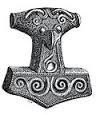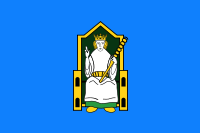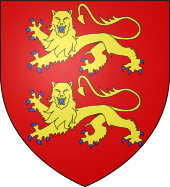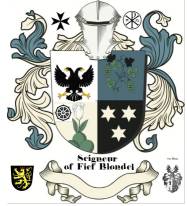Baron Longford Baron Annaly - Feudal Principality Seignory




⚜️ The Regalian Jurisdiction of Longford–Annaly and the Feudal Principality of the Barons Delvin and Earls of WestmeathI. Origins of Feudal Authority – The Lordship of Meath and the De Lacy–Nugent Connection (1172–1202)Following the Norman invasion of Ireland (1172), King Henry II of England rewarded his loyal knight Hugh de Lacy with the Lordship of Meath, to be held by the service of fifty knights. This lordship was among the greatest seigniorial fiefs in Ireland, carrying regalian privileges unknown elsewhere — including the four royal pleas of arson, forestalling, rape, and treasure trove — and thus functioning almost as a palatinate within the realm. Around 1202, Hugh de Lacy granted to Sir Gilbert de Nugent, his companion and chief retainer, the extensive lands of
Delvin (Delbhna). This conveyance created the Barony of Delvin, which became the hereditary seat of the Nugent family for over
eight centuries. II. Early Gaelic and Anglo-Norman Integration – The Delvin Tribes and Teffian Lords (13th–15th Centuries)The lands of Delvin included the territories of the O’Fenelon (Ó Fionnalláin) and O’Skully clans, ancient chiefs of Teffia (Tethba) — the precursor to modern Longford. These Gaelic septs became vassals under the De Nugents, who blended Norman seignorial structure with native Irish lordship customs. By the fifteenth century, the Barons Delvin were entrenched as the only hereditary nobility of Westmeath, acting as local governors for the Crown and
arbiters of both English and Gaelic inhabitants. III. Tudor Reorganization and the Reassertion of Feudal Rights (1494–1550)The Tudor monarchs recognized the Delvins’ role as loyal intermediaries between the Pale and the Gaelic west. In 1494, Gilbert Nugent, Baron of Delvin, was appointed Chief Captain of the King’s Forces in Ireland by Henry VII, with a salary of £200 yearly. This commission placed him in charge of all royal troops in the island — effectively the Crown’s Captain-General, an office of princely command. Two years later, in 1496, Richard, 7th Baron Delvin, was made Commander and Leader-in-Chief of all Forces of Dublin, Meath, Kildare, and
Louth, further cementing the family’s regalian status. IV. The Tudor Expansion into Annaly and the O’Farrell Lands (1552–1565)The sixteenth century saw the absorption of the old Gaelic principality of Annaly (Anghaile) into Crown control. The region, historically ruled by the Princes O’Farrell, corresponded to the modern County Longford and parts of Westmeath. In 1552, King Edward VI granted to Baron Delvin extensive estates within Annaly — including the Monastery and Holy Island (Inchcleraun / Lough Ree), as well as the Priory of Inchmore (Lough Gowna) — to hold in capite by knight’s service. These were not mere religious lands; they were strategic strongholds symbolizing sovereignty over the O’Farrell territory. Further royal charters by Philip and Mary (1556–1557) expanded the Delvin estate to include:
These grants predated the formal creation of County Longford, showing that the Delvins were recognized as feudal lords of Annaly before it was a county. V. The Captaincy and Chiefship of Slewaght William (1565)In 1565, Queen Elizabeth I granted to Christopher Nugent, Baron Delvin, the Captainship and Chiefship of Slewaght William (Clan Liam) — a hereditary
captaincy and chieftainship within the Annaly region, centered around
Ardagh and Edgeworthstown. VI. Market, Fair, and Court Rights – The Economic Jurisdiction of Annaly (1605)In 1605, King James I issued a market and fair charter to the Baron Delvin, granting him the right to hold a weekly Thursday market and a yearly fair on August 1st at Longford, with all accompanying courts baron, courts leet, tolls, and profits. This grant symbolized royal recognition of Longford (the ancient Longphort Uí Fhearghail) as the capital seat of Annaly, with Delvin as its baronial overlord and market lord. VII. James I and the Confirmation of Feudal Rights (1609–1620)Between 1609 and 1620, King James reissued and expanded grants to the Nugents of Delvin, reaffirming their rights “in capite by military service” to the lands, abbeys, and castles of the Annaly region, including:
Each of these grants explicitly carried with it courts leet, view of frankpledge, power to appoint seneschals, and jurisdiction in civil actions — the hallmarks of a manorial court of record. The Charter of 1609 effectively confirmed the Seignory of Annaly–Longford as a feudal liberty held directly from the Crown, preserving the regalian rights of the Barons Delvin. VIII. Creation of the Earldom of Westmeath and Papal Recognition (1621–1635)In 1621, Richard Nugent, 9th Baron Delvin, was elevated by King James I to
Earl of Westmeath, formally uniting the Delvin and Annaly–Longford territories
under a single comital dignity. IX. Character and Legal Standing of the Annaly SeignoryThe long chain of royal grants and offices — beginning with the De Lacy–Nugent fief of 1202
and culminating in the James I confirmations — demonstrates that the Lordship of Annaly (Longford) functioned as a regalian seignory: By English legal definition, this constitutes a Feudal Barony; by Irish and Continental analogy, it amounted to a
Feudal Principality. X. Conclusion: The Regalian Legacy of the Baron's Delvin & Nugent Lords of Longford–AnnalyFrom the first Norman partition of Meath in the twelfth century to the Jacobean confirmations
of the seventeenth, the Nugents of Delvin and Westmeath preserved a continuous chain of
feudal sovereignty, military command, and manorial justice over
Longford–Annaly. The ancient princely lordships of Annaly and Delvin (Delbhna–Teffia) were originally ruled by the O’Fearghail (O’Farrell) dynasty, Princes of Anghaile, together with the noble septs of O’Quinn (Ó Cuinn) of Rathcline, Mac Gilligan (Mac Giollagáin) of Muintir Gilligan, O’Mulfeeney (Ó Maolfhíneadha) of Corcard, O’Duignan (Ó Duibhgeannáin) of Ardagh, O’Skelly (Ó Scealláin) and O’Skully (Ó Scolaighe) of South Teffia, O’Reilly (Ó Raghallaigh) and O’Murray (Ó Muireadhaigh) on the eastern borders, Mac Donough (Mac Donnchadha) and O’Hanley (Ó hAinle) near Lough Ree, and the O’Fenelon (Ó Fionnaláin) and O’Finnallan chiefs of the ancient Delbhna or Delvin tribes of Western Westmeath—collectively forming the hereditary nobility of the old kingdom of Teffia, later known as the Principality of Annaly. Thus, under both English feudal law and Gaelic custom, the Annaly–Longford seignory stands as a true Feudal Barony with Regalian Jurisdiction — in substance a Principality under the Crown. |
About Longford Pedigree of Longford Annaly Honour of Annaly Longford The Seigneur Lords Paramount Ireland Market & Fair Chief Captain Kings Forces Chief and Captainship of The Annaly Lord Governor of Annaly Prince of Annaly Principality Chief of the Annaly Princes of Longford Feudal Princes of WestMeath Count of the Palatine of Meath A Barony Explained Princes of Annaly Pedigree Sovereign Title Succession Lord of St. Brigit's Longford Abbey Est. 1578 Lord of the Pale Commissioners of the Peace Tenures Abolition Act 1662 - Rights to Sit in Parliament Law of Ireland Seneschal of Meath List of Townlands of Longford Annaly English Pale Kings of Hy Niall Colmanians Court Barons News Irish Kingdoms Lordships of Granard Fishing & Dams Rights Rights of Lords & Barons Datuk Seri Baliwick of Ennerdale Moneylagen Feudal Barons Styles and Dignities Lord Baron Longford Baron de Delvyn Longford Map Lord Baron of Delvin Baron of Temple-Michael Baron of Annaly Kingdom Annaly Lord Conmaicne Baron Annaly Order of Saint Patrick Baron Lerha Granard Baron AbbeyLara Baronies of Longford Princes of Conmhaícne Angaile or Muintir Angaile Baron Lisnanagh or Lissaghanedan Baron Moyashel Moiety of Ardagh Baron Rathline Abbeys of Longford Grants to Delvin Baron Inchcleraun HOLY ISLAND Quaker Island Longoford CO Abbey of All Saints Hereditaments Kingdom of Uí Maine Baron Dungannon Baron Monilagan - Babington Lord Liserdawle Castle Baron Columbkille Kingdom of Breifne or Breny Baron Kilthorne Baron Granarde Count of Killasonna Baron Skryne Baron Cairbre-Gabhra AbbeyShrule Fiefs of the Islands Feudal Westmeath The Island Lords Fief Worship Channel Island History Fief Blondel Fief Blondel Merchandise Events Blondel and King Richard Fief Coin Feudal Guernsey Titles The Feudal System Flag & Arms Castle Site Map Disclaimer Blondel Myth Dictionary Honorable Colonel Mentz Order of St. Columba Valuation of Principality & Barony of Annaly Longford
Feudal Baron of Longford Annaly - Baron Longford Delvin Lord Baron &
Freiherr of Longford Annaly Feudal Barony Principality Count Kingdom of Meath - Feudal Lord of the Fief
Blondel of the Nordic Channel Islands Guernsey Est. 1179 George Mentz
Bio -
George Mentz Noble Title -
George Mentz Ambassador - Order of the Genet
Knighthood Feudalherr - Fief Blondel von der Nordischen
Insel Guernsey Est. 1179 * New York Gazette ®
- Magazine of Wall Street - George
Mentz - George
Mentz - Aspen Commission - Ennerdale - Stoborough - ESG
Commission - Ethnic Lives Matter
- Chartered Financial Manager -
George Mentz
Economist -
George Mentz Ambassador -
George Mentz - George Mentz Celebrity -
George Mentz Speaker - George Mentz Audio Books - George Mentz Courses - George Mentz Celebrity Speaker Wealth
Management -
Counselor George Mentz Esq. - Seigneur Feif Blondel - Lord Baron
Longford Annaly Westmeath
www.BaronLongford.com * www.FiefBlondel.com |




Commissioner George Mentz - George
Mentz Law Professor - George
Mentz Economist
George Mentz News -
George Mentz Illuminati Historian -
George Mentz Net Worth
The Globe and Mail George Mentz
Get Certifications in Finance and Banking to Have Career Growth | AP News